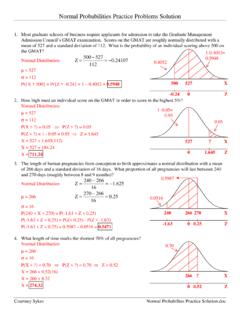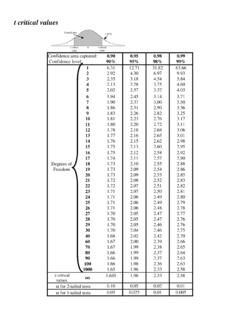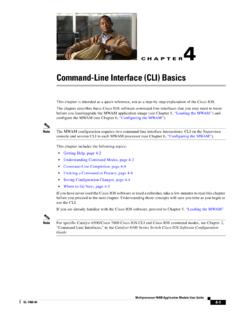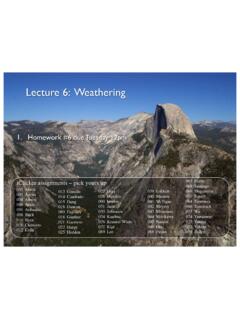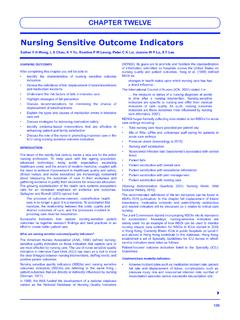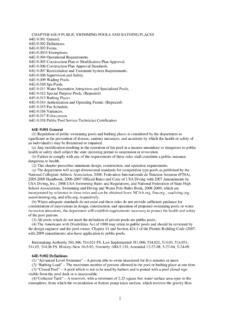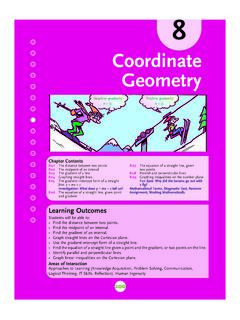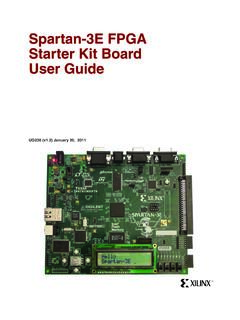Transcription of Scatter Diagrams Correlation Classifications
1 Scatter Diagrams Correlation Classifications Scatter Diagrams are used to demonstrate Correlation between two Correlation can be quantitative variables. 19. classified into three basic Regression Plot 18. categories 19. Often, this Correlation is 17 18. linear. Linear 17. Weight 16. Weight 16. This means that a straight 15 Nonlinear 15. 14. line model can be No Correlation 14. 13. 13. developed. 12. 12. 20 21 22 23 24. Length 20 21 22 23 24. Length chapter 5 # 1 chapter 5 # 2. Correlation Classifications Correlation Classifications Two variables may be correlated but not through Curvilinear Correlation a linear model. 500 50. 400 Two quantitative 40. This type of model is 30. 300 variables may not be result 20. called non-linear 10. 200. correlated at all C4. 0. The model might be one 100 -10. -20. 0. of a curve. 0 5 10 15. -30. -40.
2 Sample 0 5 10 15 20 25. Animalno chapter 5 # 3 chapter 5 # 4. Linear Correlation Linear Correlation Variables that are Regression Plot correlated through a linear relationship can 19. Negatively correlated Regression Plot display either positive 18. variables vary as 17. or negative Correlation opposites 4. Weight 16. Positively correlated 15 As the value of one Student GPA. variables vary directly. 14. variable increases the 13 3. 12. other decreases 20 21 22 23 24. Length 2. 0 10 20 30 40. Hours Worked chapter 5 # 5 chapter 5 # 6. Strength of Correlation Strength of Correlation Correlation may be strong, When the data is moderate, or weak. Regression Plot distributed quite close Regression Plot You can estimate the to the line the 95. 90. strength be observing the 4. Correlation is said to 85. Final Exam Score variation of the points be strong 80.
3 75. Student GPA. around the line 3. The Correlation type is 70. 65. Large variation is weak independent of the 60. 55. Correlation strength. 50. 2 55 65 75 85 95. 0 10 20 30 40. Midterm Stats Grade Hours Worked chapter 5 # 7 chapter 5 # 8. The Correlation Coefficient Interpreting r The sign of the Correlation coefficient tells us the The strength of a linear relationship is measured direction of the linear relationship by the Correlation coefficient If r is negative (<0) the Correlation is negative. The The sample Correlation coefficient is given the line slopes down symbol r If r is positive (> 0) the Correlation is positive. The The population Correlation coefficient has the line slopes up symbol . chapter 5 # 9 chapter 5 # 10. Interpreting r Cautions The size (magnitude) of the Correlation The Correlation coefficient only gives us an coefficient tells us the strength of a linear indication about the strength of a linear relationship relationship.
4 If | r | > implies a strong linear association Two variables may have a strong curvilinear For < | r | < implies a moderate linear relationship, but they could have a weak value association for r For | r | < this is a weak linear association chapter 5 # 11 chapter 5 # 12. Fundamental Rule of Correlation Setting Correlation DOES NOT imply causation A chemical engineer would like to determine if a Just because two variables are highly correlated does relationship exists between the extrusion not mean that the explanatory variable causes the response temperature and the strength of a certain formulation of plastic. She oversees the production of 15 batches of plastic at various Recall the discussion about the Correlation temperatures and records the strength results. between sexual assaults and ice cream cone sales chapter 5 # 13 chapter 5 # 14.
5 The Study Variables The Experimental Data The two variables of interest in this study are the strength of the plastic and the extrusion temperature. The independent variable is extrusion temp. This is the Temp 120 125 130 135 140. variable over which the experimenter has control. She Str 18 22 28 31 36. can set this at whatever level she sees as appropriate. The response variable is strength. The value of strength Temp 145 150 155 160 165. is thought to be dependent on temperature. Str 40 47 50 52 58. chapter 5 # 15 chapter 5 # 16. The Scatter Plot Conclusions by Inspection The Scatter diagram for Does there appear to be a relationship between the the temperature versus Scatter diagram of Strength vs Temperature 60. study variables? strength data allows us to Classify the relationship as: Linear, curvilinear, no Strength (psi). 50.
6 Deduce the nature of the relationship between these 40 relationship two variables 30 Classify the Correlation as positive, negative, or no 20 Correlation 120 130 140 150. Temperature (F). 160 170. Classify the strength of the Correlation as strong, moderate, weak, or none What can we conclude simply from the Scatter diagram? chapter 5 # 17 chapter 5 # 18. Computing r Computing r 1 x x y y . [(Z x )(Z y )]. 1. r = r =. n 1 s x s y . n 1. z-scores df z-scores for y data for x data chapter 5 # 19 chapter 5 # 20. Computing r - Example Classifying the strength of linear Correlation The strength of a linear Correlation between the response See example handout for the plastic strength versus and the explanatory variable can be assigned based on r extrusion temperature setting These Classifications are discipline dependent chapter 5 # 21 chapter 5 # 22.
7 Scatter Diagrams and Statistical Classifying the strength of linear Modeling and Regression Correlation For this class the following criteria are adopted: We've already seen that the best graphic for illustrating the relation between two quantitative If |r| > then the Correlation is strong variables is a Scatter diagram. We'd like to take If |r| < then the Correlation is weak this concept a step farther and, actually develop a mathematical model for the relationship between two quantitative variables If < |r| < then the Correlation is moderate chapter 5 # 23 chapter 5 # 24. Using the Line of Best Fit to Make The Line of Best Fit Plot Predictions Since the data appears to be linearly related we can find a straight line model 60 Based on this graphical 60. that fits the data better 50. model, what is the than all other possible predicted strength for 50.
8 Strength Strength 40. straight line models. plastic that has been 40. 30. extruded at 142 degrees? This is the Line of Best 30. 20. Fit (LOBF) 120 130 140 150 160 170. 20. Temp 120 130 140 150 160 170. Temp chapter 5 # 25 chapter 5 # 26. Using the Line of Best Fit to Make Using the Line of Best Fit to Make Predictions Predictions Given a value for the predictor variable, determine Based on this graphical the corresponding value of model, at what 60. the dependent variable temperature would I need 50. graphically. to extrude the plastic in Strength Based on this model we 40. order to achieve a strength would predict a strength of appx. 39 psi for plastic of 45 psi? 30. extruded at 142 F 20. 120 130 140 150 160 170. Temp chapter 5 # 27 chapter 5 # 28. Using the Line of Best Fit to Make Predictions Computing the LSR model Locate 45 on the response axis (y-axis) Given a LSR line for bivariate data, we can use that Draw a horizontal line to line to make predictions.
9 The LOBF. Drop a vertical line down How do we come up with the best linear model to the independent axis from all possible models? The intercepted value is the temp. required to achieve a strength of 45. psi chapter 5 # 29 chapter 5 # 30. Bivariate data and the sample linear The straight line model regression model For example, look at Any straight line is completely defined by two the fitted line plot of parameters: powerboat The slope steepness either positive or negative registrations and the number of manatees The y-intercept this is where the graph crosses the killed. vertical axis It appears that a linear model would be a good one. y = b o + b1 x chapter 5 # 31 chapter 5 # 32. The Parameter Estimators Calculating the Parameter Estimators The equation for the LOBF is: In our model b0 is the estimator for the intercept. The true value for this parameter is 0.
10 B1 estimates the slope. The true value for this y = bo + b1 x parameter is 1. chapter 5 # 33 chapter 5 # 34. Calculating the Parameter Estimators Computing the Intercept Estimator To get the slope estimator we use: The intercept estimator is computed from the variable means and the slope: n (x y ) x y b1 =. ( ). n x 2 ( x ). 2 b0 = y b1 x or Realize that both the slope and intercept sy estimated in these last two slides are really point b 1 = r estimates for the true slope and y-intercept sx chapter 5 # 35 chapter 5 # 36. Revisit the manatee example Computing the estimators Look at the summary statistics and Correlation coefficient data from the manatee example So the slope is: Variable N Mean SEMean StDev s . Boats 10 b1 = r y . Deaths 10 sx .. Minitab Correlation coefficient output b1 = = Correlations: Boats, Deaths . Pearson Correlation of Boats and Deaths = P-Value = chapter 5 # 37 chapter 5 # 38.

